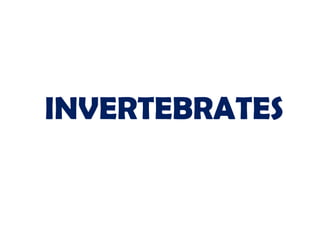Invertebrates_Edtech101
- 2. Invertebrates ? Animals without backbones ? 97% of all animal species
- 3. Invertebrates Phylum Annelida Phylum Porifera Phylum Molluska Phylum Cnidaria Phylum Echinodermata Phylum Platyhelminthes Phylum Arthropoda Phylum Nematoda
- 4. PHYLUM PORIFERA (Sponges) ? °∞Porifera°± means pore ®C bearing ? lacks true tissues & organs; incomplete digestive system ? has skeleton that supports & protects the body; made up of °∞spicules°±
- 6. PHYLUM CNIDARIA ? Radially symmetric ? digestive chambers with a single opening, which serves as both mouth & anus ? Includes: hydras, jellyfish, corals and sea anemones
- 7. PHYLUM CNIDARIA 2 body forms: polyp form and medusa form 1. polyp form - cylindrical; mouth & tentacles at the upper end 2. medusa form ®C shaped like an upside-down bowl; mouth & tentacles facing downward has tentacles with stinging cells called °∞cnidocytes°± that paralyzes their preys Jellyfish -medusa Coral - polyp
- 8. Sea anemones Jellyfish Coral Hydra
- 9. PHYLUM PLATYHELMINTHES (Flatworms) ? with flattened bodies; bilateral symmetry ? lacks body cavity ? most flatworms are parasites
- 10. PHYLUM PLATYHELMINTHES (Flatworms) ? 3 major groups: flukes, planaria & tapeworms 1. Flukes ®C parasites that absorb the nutrients from the body of a host harming it; causes a disease called schistosomiasis 2. Planarians ®C non-parasitic, lives in moist environments & free-living 3. Tapeworms ®C long ribbon-like flatworm; can infect humans through eating undercooked meat of an infected cow or pig
- 12. PHYLUM NEMATODA (Roundworms) ? has cylindrical bodies tapered at both ends & covered by a tough cuticle ? includes parasitic types: trichina, filaria, pinworms, & hookworms ? Many are introduced through poorly cooked pork or walking barefoot in contaminated areas. ? Some diseases caused by roundworms: elephantiasis, trichinosis.
- 13. Pinworm Filaria Hookworms Trichina
- 14. PHYLUM ANNELIDA (Segmented Worms) ? With segmented bodies which has a ringed appearance ? Includes: earthworms & leeches
- 15. PHYLUM MOLLUSKA (Mollusks) ? Second largest animal phylum ? Includes: oyster, clams, snails, squids and octopuses ? Some are sources of food for humans.
- 16. Oysters Clams
- 17. Snail Squid Octopus
- 18. PHYLUM ECHINODERMATA (Spiny-skinned) ? Includes: starfish, sea urchin and sea cucumbers ? Has internal skeleton for support & protection
- 19. Starfishes Sea cucumber Sea urchins
- 20. PHYLUM ARTHROPODA (Arthropods) ? Largest group in the animal kingdom ? Has exoskeleton; segmented body & joint appendages ? Divided into 4 groups: 1. Crustaceans ®C lobsters, shrimps, crabs & crayfish 2. Insects ®C ants, mosquitoes, bees, wasps, bugs & flies 3. Arachnids ®C spiders, mites & scorpions 4. Myriapods ®C centipedes & millipedes
- 21. Lobster Crayfish Shrimp Crustaceans Crabs Hermit crab
- 23. Arachnids Ticks Spiders Scorpion Mites
- 24. Myriapods
- 25. The End

























